
Tip Top Toy Company

The April, 1945 issue of Mechanix Illustrated magazine had an article by Oden and Olivia Meeker with the title : "Handyman Clown." The article details the small custom toy making bussiness that A. Robins ran from his White Plains, NY home basement. It is the first known specific references in print linking A. Robins to the use of bananas in the Banana Man act. It offers fascinating insight into his routine and the statistics on the numbers of productrion items - and where the CONCEPT for the various productions came from. The many pictures (by Allan Gould) offer special views of A. Robins out of makeup and show his pristine, well-organized workshop.
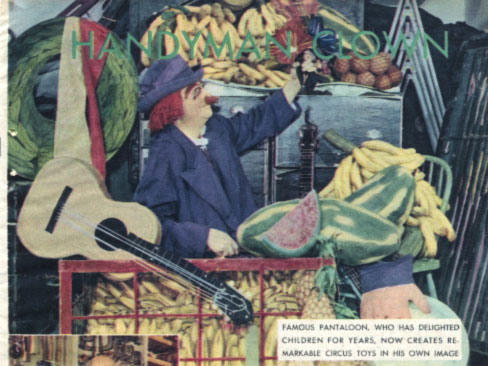
A few months ago a desperate mother ransacked most of new
York for the jack-in-the-box demanded by her sick child.
Finally she appealed to a newspaper, which in turn called on
A. Robins, a Viennese clown now living in surburban White
Plains. Within a few days the child hada a specially made,
bright red jack-in-the-box, complete with pop eyes, long
nose and a rediculous grin. A. Robins likes to make toys. Though he is a veteran of
40 years in show bussiness and the originator of an act
which has brought him up to a thousand a week, his idea of
contentment is to spend most of his time in his cellar
workshop. There he dreams up new models for the Tip Top Toy
Co. - another name for A. Robins. Robins' toys, which retail from about a dollar fifty to
three dollars, are sold by the thousands through outlets
ranging from department stores like Macy's to Longchamps'
chain restaurants and Jane Engel dress shops. All the toys
do something. Most of them follow vaudeville and circus
motifs, are gaudily painted and made entirely of wood - held
together with dowels and glue instead of the customary
nails, importand in days of priority and shortage. Typical
Tip Top products are: a fat yellow duck with a long red neck
which shoots out like a piston, and a clown balancing a
feather on his nose, who relvolves on one foot as he is
pulled along on his little platform. "Swingin' Sam," the
most popular of Robins' creations, is a crazily disjointed
clown acrobat who plays on a horizontal bar. "The Tip Top
Trio" comprises a red, yellow and a green clown who perform
infinite varieties of acrobatics on their platform by means
of dowels and coresponding holes. Robins is a handy man. His workshop, which is unusually
neat, manages to compress an enormous number of tools into a
very small place, and still leave room for his black poodle,
Curly, who likes to watch the work. Almost everything in the
room except for his working materials was made by Robins
himself. This includes his tool cabinets, the decorations
and the purple batik window curtains which sport stylized
representations of famous European clowns. Robins adamits he
had to buy his very fancy mortiser for drilling square
holes. Even Robins' act depends basically on his own labor.
While on stage he extracts from his large purple coat, among
other things, a waste basket, a mop, a cigar box, an outsize
magnet, a coctail set, 12 mandolins, 24 neckties, a music
stand, an oboe, a camp stool, six watermelons, a French
railway conductor's uniform, a bass drum and 296
bananas. "I got the idea," says Robins, "from watching a chorus
girl hunt through her bag for a lipstick." The coat itself weighs 75 pounds and takes him about two
and a half hours to load. It's taken Robins, 57 now, most of
his lifetime to build the act as it stands today. His cellar
holds some 50 trunks of props which he has built himself.
His act is unique. And it's an idea that will never be
stolen - no one else would have the patience to start
building it again from the beginning. Robins' routine runs roughly like this. Equipped with a
pince-nez and violent red yarn wig and moustache, and
dressed in his long purple coat, he walks on stage, unzips a
banana equipped with a slide fastener, and throws the fruit
away. He slips on the banana peel, and is forced to pull out
a pail and a long-handled mop to clean it up. Taking out
some sheet music, he then produces a violin with which to
play it. Pulling out a music stand and a stool from his
coat, he settles down to work in earnest, all the while
humming a lunatic little tune in falsetto. He becomes angry
with the music, crumples it into a ball but has nowhere to
put it. Out comes a waste basket. He solaces himself with an
apple, but doesn't like it. Reaching into his coat he begins
to pull out fruit - pineapples, bags of oranges and always
more and more bananas. These bananas, typical of Robins' collapsible props, are
made of carefully painted cloth covers stretched over
springs which are fastened to six thin brass rods on a
single base. Compressed, the 296 bananas can be folded into
a space about twice the size of a cigar box. By mechanical
releases they can be taken off in any number of bunches. Everything comes forth in an insane but logical sequence.
When Robins pulls out his coctail equipment, seltzer water
shoots out of his coat. And everything is compressed to the ultimate. A lampshade
which he puts on his had suddenly unfolds and bewcomes a
colored man sitting on a barrel and playing a banjo. Robins, who claims unrivaled the title of the World's
Most Dressed Man, remarks: "When I come on stage, I feel
heavy and tired. I'm suffering from the heat. Then I start
to work. The faster and longer I work, the lighter I feel
and the cooler I get. When I walk off, I'm feeling
fine." As someone remarked, "He's the only entertainer in the
U.S. theatre who takes off more and reveals less than Gypsy
Rose Lee." Nevertheless, Robins feels the strain of his act. In
recent years he's played everything from the Radio City
Music Hall to Midwestern nightclubs and a circus in Mexico.
He hates the five-a-day grind in movie houses which must
sandwich vaudeville in between every screening. "I can't go out to eat ... wife brings me a sandwich ...
no time to eat it ... comes supper after the show ... too
tired to eat. "I don't want to be the richest clown in the cemetary."
he adds firmly. He still plays an occasional date as a clown, however he
doesn't mind doing a musical (he worked in both Billy Rose's
"Jumbo" and the original Folies Bergeres), but these
days A. Robins in concentrating on his toys. He's never
outgrown toys and sees no reason why he should. A mild, balding little man with the face of a cheerful
pumpkin, he seems to be thriving on toy making and Mrs.
Robins' Hungarian cookery. She confines herself largely to
the domestic side of the act, although for a while during
the last war, when theatre orchestras were cut down, she did
come on stage dressed as an Italian with a barrel organ to
accompany her husband. Mrs. Robins' job now includes washing
and ironing the all-important bananas once every two weeks
during an engagement. Robins - the Banana Man, the Walking Cornucopia, the
Fruitful Frankenstein, the One Man Mail Order House - was
born plain A. Proper, the son of a small dry goods merchant
in Vienna. The A. stands for something, but Robins' dislike
of the name amounts to almost an obsession, and he's
horrified at the thought of it in print. At 17 he took a job
in a local honkey-tonk doing a comedy musical turn and
helping out with the skits by playing everything from
animals to wizened old gaffers. Then following a lightning
sketch act in vaudeville. The boffo finale of this turn was
a quick dive through a sea-scape which he had just painted
on a paper hoop. About this time he changed his name from Proper to
Robins. "Like Reubens," he says, "another painter." The turning point in his career came one day when a car
honked at him on the street. He honked back. One thing led
to another until he found himself billed as the Walking
Music Store and in great demand as an imitator of
saxophones, susaphones, contra-bassoons, glockenspiels and
so on. He claims to have spent, at this period of his life,
an entire evening impersonating a violin in an
orchestra. As Robins worked himself up to the big time, his dressing
room became more and more of a madhouse. A visitor took
partial inventory at one point and counted a trunk full of
paints, a portable sewing machine, a midget tailor shop, and
a tinsmith's outfit which rested on top of a portable forge.
The Robins colection of props became truly astonishing. His father, who didn't apporve of such foolishness as
show business, would never come to see the act. The first
time Robins made a sizeable amount of money he had to work
hard to persuade his father that he had come by it
honestly. He and his parents had had so little that his one
ambition became to take careof them. Finally he designed and
built a house for his mother, but she died without ever
having seen it. Today Robins' position is assured. He has become
something of a legend in show business, a holdover from the
days of the great individual clowns like Grock, Toto,
Marceline and the Fratellinis. Underpaid circus joeys who
came on 20 to 30 at one time for a brief walkaround, look
with awe on Robins who has ten minutes all to himself and
comands a fat salary in the bargain. Currently, Robins and his partner, Karl Tausig, who used
to be his travel agent, are opening a new factory of their
own in Brooklyn. Tausig, who handles the business end of Tip
Top, likes to play with toys too. Together they have been
highly sucessful, and plan for enormously increased
production after the war. Robins learns as he goes, discarding ideas that are
impractical. The toys he designs must be both sturdy and
inexpensive. If reasonably sucessful, a model will enjoy a
production life of about three years. Robins is a little appalled at the younger generation of
Americans: "They're too smart. They've got closets full of
toys and they get tired of them. When I was little, I had no
toys. Only a hammer and a piece of wood." His comments on toy manufacturers are equazlly heretical:
"Most of them are business men. All they do is steal from
each other. I think up my own toys." Some of his ideas come from his library of books of
historical toys. But most are his own. As Robins says: "They must appeal to the parents. They
buy them. And they must appeal to the children. They break
them."
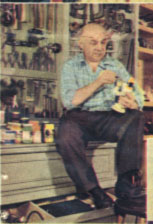

In the tiny basement workshop of his home, Robins designs
his own toys, makes the first models. Viennese-born Robins
is one of the world's great clowns. He's famous for costumes
like the one here.
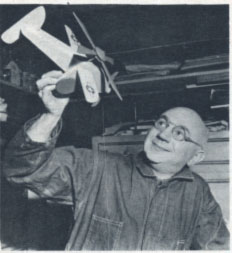
The ex-clown sells his original designs to a
toy company which then produces them in
quantity.

Large tool on the beautifully neat work table is a speciaal
drill for making square holes in toy parts.
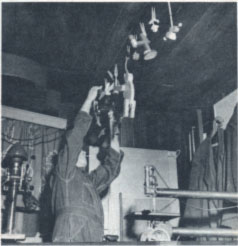
Despite smallness, workshop contains all necessary tools.
Here newly-painted toys are hung up to dry.
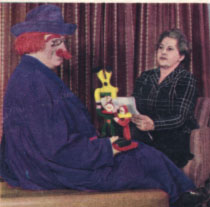
Robins gets some of his best ideas for toys from sketches of
himself in costume made by his wife.
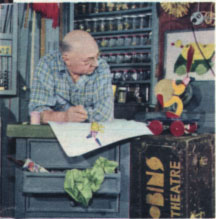
Old books of quaint drawings and toys of another day also
serve as inspirations for new designs.
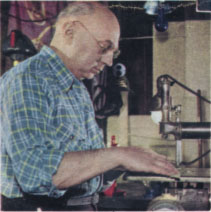
A skilled worker, Robins makes the first model himself and
turns it over to toy company to copy.
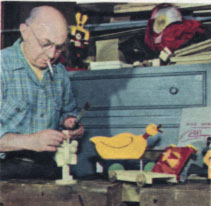
All his toys have the same appealing liveliness that made
him a great clown. Kids love them.

A large collection of heads in various sizes and shapes is
kept to try on new body designs.
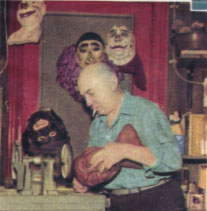
Mask-making comes naturally to the ex-clown. Making mask of
his face has been lifetime job.

These two push toys (one missing the handle) were found in the
theatrical trunks belonging to the Banana Man and are very likely
prototypes of toys to be issued by the Tip Top Toy Company. When
pushed, a clown's head popped out of the top of the box and a bell on
the bottom rung.
The Pull Toy Seal
In May, 2005, a pull toy was purchased on eBay. When the small platform with the seal is pulled, the balanced cube rotates. The toy even still has the original manufacturer's label pasted on the bottom. This all wooden toy with an ingenious mechanism for rotating the cube on the seal's nose was almost certainly constructed and painted by the hands of A. Robins. The various parts were obviously hand cut on a bandsaw and other basement workshop tools and not the product of a mass production assembly line.

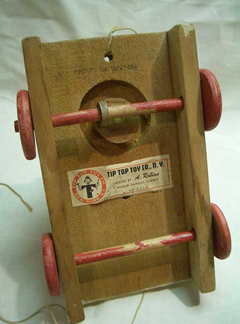
The label glued to the bottom of the pull toy is charming. It has the cartoon image of A. Robins holding the hammer (he built it) and the paint brush (he painted it.)
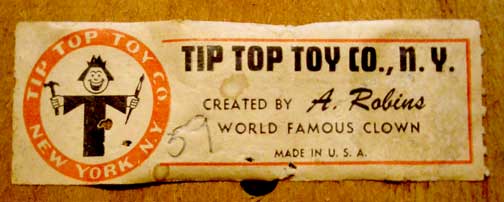
The Clown Acrobat

In September, 2005, a second Tip Top Toy was purchased on eBay. It is also authentically made by A. Robins as evidenced by the label on the bottom of the toy. The jointed clown will do acrobatics on the bar when the end balls are turned.
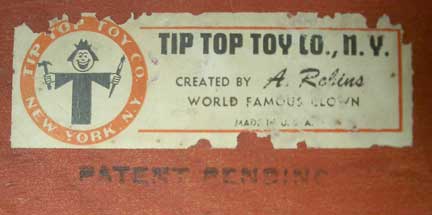
An interesting addition to this label is the hand rubber stamped with
"Patent Pending." NOW, I have to staert patent searches!
Patent searching has proven PRODUCTIVE. Adolf
Robins, White Palins, N.Y., assignor to Tip Top Toy Company, a
copartnership consisting of Karl Tausig, New York and Adolf Robins,
White Palins, N.Y. were granted United States patent number 2,377,811
on June 5, 1945 (Having applied 13 months earlier.)
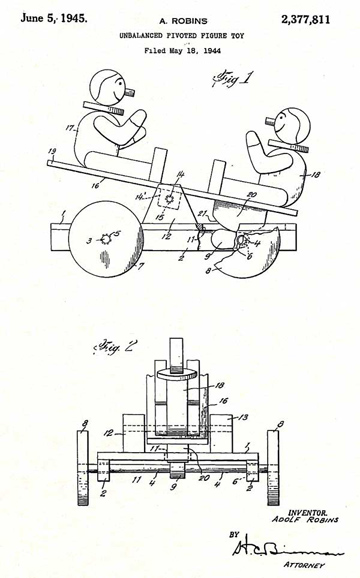

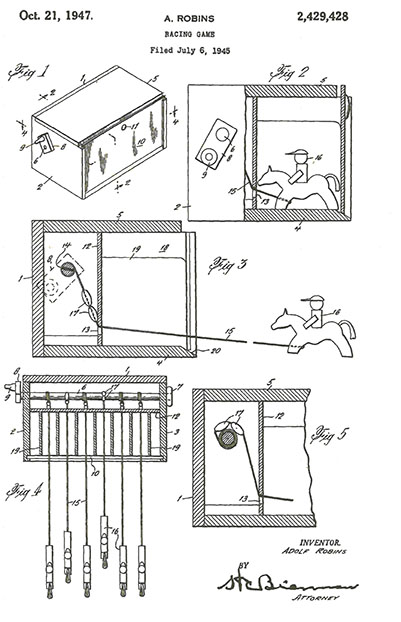
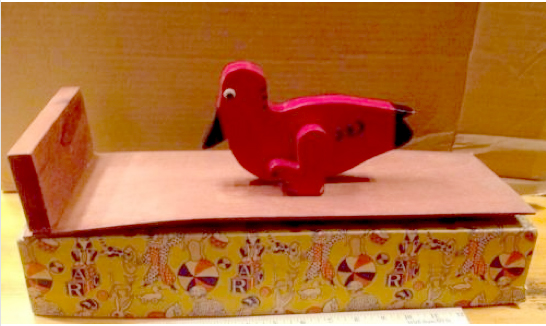
An article from Collier's Magazine
featured A. Robins and his Tip Top Toy Company
Laugh Factory
By F. Beverly Kelly & Don Lang
Photographs for Collier‚ by Emil F. Herman
Colliers ‚ October 16, 1942
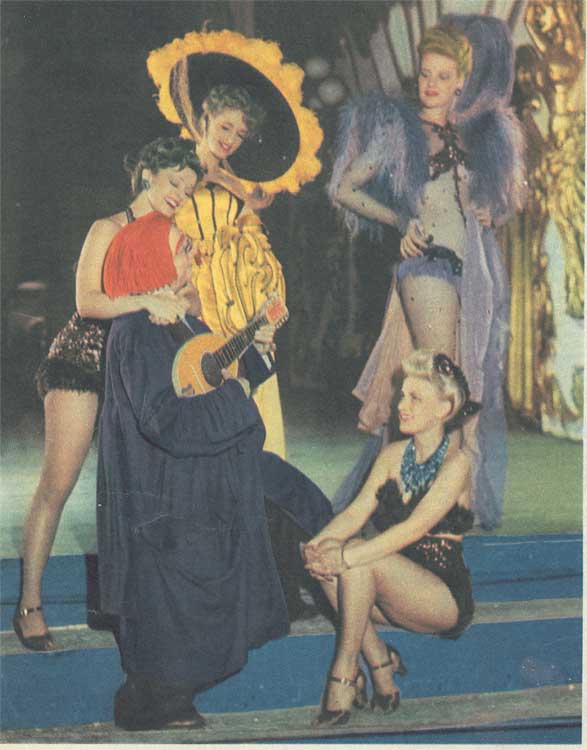
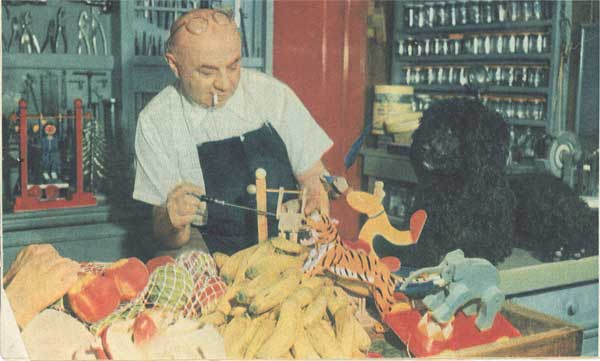
(Caption for photographs: Even the girls of Spangles thought A. Robins was funny. In the copious coat are oranges, bananas, a mop, a magnet, a hatchett, cigars ‚ all of which Robins makes at his workbench in his White Plains, NY, Home)
THE "laugh factory" at White Plains, New York, won't receive the Army-Navy "E" Award, but it is working overtime these days to produce the stuff that makes folks relax and chuckle and roar and beat their hands together. Boss and sole employee is A. Robins, the Banana Clown. He produces fabulous quantities of bananas from his pockets at frequent intervals to punctuate a twelve‚Äėminute act. He makes his own bananas.
They really look like bananas, and so do the huge watermelons look real. The same goes for a bag of pineapples, two dozen oranges, and a music rack, wastebasket, mop, giant magnet, thirty neckties, a box of cigars, cocktail shaker and two big bottles, a hatchet and various other incongruous items concealed in a network of pockets of a long purple coat that would make a professional shoplifter bite his handcuffs in envy.
Robins is the highest paid clown in the business. He was featured during the summer in the new, continental style show, Spangles, which Robert Ringling produced as a baby sister to the huge Ringling Brothers-Barnum & Bailey show. Spangles was a one-ringer and that is why Robins was there. He belongs to a school of buffoonery that needs the spotlight and plenty of time.
Robins used to be Adolph Proper, and his dad was a small dry-goods merchant in old Vienna. Proper, Sr., worked hard - counted pfennigs all his life and worried eternally about how to make ends meet. He was always in debt and frequently behind in the rent. The boy Adolph saw no reason for this poverty. He had an ambition to get on the stage and make some real money.
His father persuaded him to spend one year in business school, thinking that in a year the lad would forget the stage. He was wrong. The boy left school at seventeen and had to take what he could find - a job designing dresses. Later, he got a job in a night club as a quick painter.
Walking along a Vienna street one day, he heard an auto horn and, being in high spirits, honked back at it. To his surprise, this fine, realistic honk sent people scurrying in every direction. He experimented further. Out of this talent came the second phase of the Robins act - the imitation of many instruments. Stagehands broke so many of them, he decided to carry them concealed on his person as he marched onto the stage, and thus was born the third or "production" phase of his performance.
The reason Robins finally hitched his star to anything as prosaic as a bunch of bananas was because they represent something nearly everybody understands. They emerge (314 of them) so readily and in such startling numbers from his pockets, and they are marvels of mechanical construction. His coat weighs seventy-five pounds loaded.
He believes that there must be some reason for everything he does. Everything must be crazy, but, at the same time, there must be some sense to it. For instance, he doesn't just pull out a mop for the sake of pulling out a mop. There is nothing funny about a mop. But first he slips on a banana peel - and out comes the mop. His big magnet would be useless if he didn't use it to pick up a glove he had dropped. A giant hand, appearing suddenly, in itself is not funny, but when he uses it to acknowledge applause, it becomes funny.
Robins' one ambition all during the years of his climb to fame and fortune was to take care of his parents by building a fine home for them and making them comfortable for the rest of their lives. His father died soon after the first World War, and then, a couple of years later, Robins stopped his American work and went back to Vienna again, to provide for his mother. He built a fine home, designing every bit of it and working for months to get it completed. Then, just as it was finished and he was preparing to move his mother in, she died, without ever having seen it.
The Pagliacci touch
|
|
|
|
|
|
|
|
|
|
|
|
|
|
|
|
|
|
©2001 Rhett Bryson
If you have ANY Banana Man stories, material or information,
Please eMail Rhett
Bryson (rhett.bryson@furman.edu)
Last Updated 07/26/2005